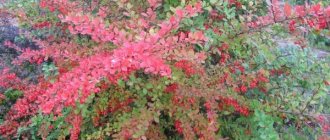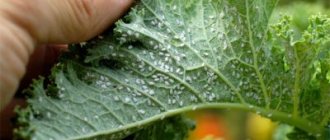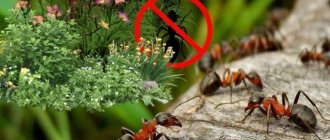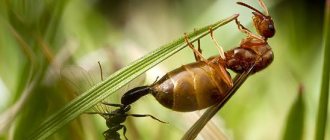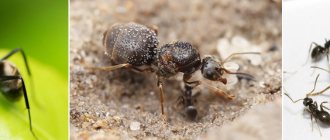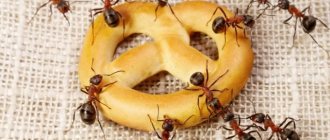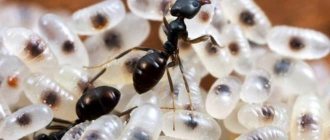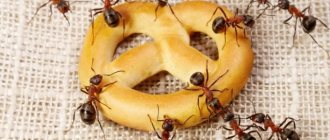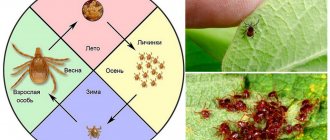Ants are small insects that live in families. One such colony can number up to a million individuals, each of which performs a specific job. The main individual of the family is the queen, thanks to which the population regularly increases. Ordinary worker ants are engaged in obtaining food and water, the search for which forces them to travel long distances. This is what causes them to enter a person’s home. However, flying ants often appear in the house. You can learn about the characteristics of pests and ways to combat them from this article.
Ant flight
In fact, this phenomenon has a completely pragmatic goal: procreation
.
At the beginning of the warm season, new males and females hatch from eggs in wild anthills. But they cannot stay in their native anthill, since an anthill can only have one owner. When the new queens are fully mature, the ant year begins: the queens set out on a journey to meet the males and undergo the fertilization procedure.
It is worth noting that the flight time of ants differs for different species and different climatic conditions.
. The biological clock of ants works in such a way that the queen has time to breed offspring and establish a new colony during the warm and satisfying summer period.
Thus, the year of ants in Russia begins in April and lasts until the beginning of October.
How to get rid of pests
The question of how to get rid of flying ants in the house will not arise if you maintain order:
- regularly carry out wet cleaning;
- remove crumbs and leftover food from the table;
- use mosquito nets on windows.
If winged ants do get into the house, you can use pesticides and folk remedies to eliminate them.
Chemicals
Insects will not fly around the house if you use effective chemicals. So you can get rid of pests at home using aerosols such as Dichlorvos, Raptor, Clean House or Combat. No less effective for this are gels, the insecticidal composition of which is transferred to the nest by ants on their paws. These include Rubit or Great Warrior.
Important!
However, due to the severe toxicity of these drugs, precautions must be taken using personal protective equipment. After finishing the treatment at home, be sure to thoroughly wash your hands and face.
People's Councils
You can also get rid of flying ants using folk remedies, which are available in every home and are safe, accessible, and also low in price:
- Bait containing yeast, boric acid and jam will have a killing effect on insects. The mixture of these ingredients is spread in a thin layer into small containers.
- Boric acid can be mixed with minced meat and placed in areas where house pests are located.
- The flying ant does not like the smell of garlic.
- Bunches of wormwood, elderberry or mint are no less effective at repelling flying insects. The aromatic oils of these plants will also help get rid of pests.
Is it possible to catch the queen
If you decide to catch a queen yourself to set up a home farm, please note that the winged queens have not yet been fertilized and will not produce brood.
Therefore, if you notice winged queens in a certain place, you can return there a few days later. And find already fertilized, wingless females. You just need to catch them very carefully so as not to damage them.
However, do not forget that wild ants can carry mites, mold spores and pathogens
. Therefore, it is better to order the queen along with the acrylic farm in a specialized store. Unlike a homemade farm, an acrylic formicarium has everything necessary for the full life and development of an anthill.
Human sp. what species live in Kyiv forests/parks?
There is such a resource: https://antmaps.org Click on the image of Ukraine on the map and you will be amazed
the abundance of species living on its territory.
Aphaenogaster splendida Aphaenogaster subterranea Aphaenogaster subterraneoides Bothriomyrmex communista Bothriomyrmex corsicus Bothriomyrmex meridionalis Bothriomyrmex modestus Camponotus aethiops Camponotus atricolor Camponotus fallax Camponotus herculeanus Camponotus lateralis Camponotus ligniperda Camponotus piceus Camponotus sanctus Camponotus va gus Cardiocondyla elegans Cardiocondyla stambuloffii Cardiocondyla ulianini Cataglyphis aenescens Colobopsis truncata Crematogaster schmidti Crematogaster scutellaris Cryptopone ochracea Dolichoderus quadripunctatus Formica aquilonia Formica bruni Formica cinerea Formica cinerea cinereoimitans Formica cinereofusca Formica cunicularia Formica exsecta Formica foreli Formica fusca Formica gagates Formica lemani Formica lugubris Formica picea Formica polyctena Formica pratensis Formica pressilabris Formica rufa Formica rufibarbis Formica sanguinea Formica truncorum Formica uralens is Formicoxenus nitidulus Harpagoxenus sublaevis Hypoponera eduardi Lasius affinis Lasius alienus Lasius balcanicus Lasius bicornis Lasius brunneus Lasius carniolicus Lasius citrinus Lasius distinguendus Lasius emarginatus Lasius flavus Lasius fuliginosus Lasius illyricus Lasius jensi Lasius longiceps Lasius meridionalis Lasius mixtus Lasius myops Lasius niger Lasius paralienus Lasius platythorax Lasius psammophilus Lasius s abularum Lasius umbratus Leptothorax acervorum Leptothorax gredleri Leptothorax muscorum Liometopum microcephalum Manica rubida Messor structor Myrmecina graminicola Myrmica bergi Myrmica constricta Myrmica deplanata Myrmica excelsa Myrmica gallienii Myrmica hellenica Myrmica karavajevi Myrmica lobicornis Myrmica lonae Myrmica rubra Myrmica ruginodis Myrmica rugulosa Myrmica sabuleti Myrmica salina Myrmica sca brinodis Myrmica schencki Myrmica slovaca Myrmica specioides Myrmica stangeana Myrmica sulcinodis Myrmica vandeli Pheidole koshewnikovi Plagiolepis karawajewi Plagiolepis pygmaea Plagiolepis taurica Plagiolepis xene Polyergus rufescens Ponera coarctata Ponera testacea Prenolepis nitens Proceratium melinum Proformica epinotalis Solenopsis fugax Solenopsis ilinei Stenamma debile Stenamma westwoodii Strongylognath us arnoldii Strongylognathus chelifer Strongylognathus christophi Strongylognathus karawajewi Strongylognathus kratochvili Strongylognathus testaceus Tapinoma erraticum Tapinoma kinburni Tapinoma madeirense Tapinoma subboreale Temnothorax affinis Temnothorax albipennis Temnothorax clypeatus Temnothorax corticalis Temnothorax crasecundus Temnothorax crassispinus Temnothorax inquilinus Temnothorax interruptus Temnothorax jailensis Temnothorax knipovitshi Temnothorax luteus Temnothorax muellerianus Temnothorax nassonovi Temnot horax nylanderi Temnothorax parvulus Temnothorax ravouxi Temnothorax recedens Temnothorax rogeri Temnothorax semenovi Temnothorax tamarae Temnothorax tauricus Temnothorax tuberum Temnothorax unifasciatus Temnothorax volgensis Tetramorium atratulum Tetramorium caespitum Tetramorium chefketi Tetramorium diomedeum Tetramorium ferox Tetramorium forte Tetramorium hungaricum Tetramorium impurum Tetramorium indocile Tetramorium meridionale Tetramorium moravicum Tetramorium semilaeve
Creation of an incubator
The next stage of preparation is the manufacture of incubators. You need to learn how to prepare apartments for the queen ant. This is done quite simply, you need to take a test tube or syringe with a sealed spout, pour boiled water into it, about one third. After this, you need to make a ball of cotton wool and push it into the test tube so that it is almost completely immersed in water. Turn the incubator over and make sure there is no water leaking. If you did everything correctly, then the queen will be able to live in this incubator and give rise to a new colony.
This is what a regular ant incubator looks like
When and how does the mating flight of ants occur?
Let's consider this process using the example of black garden ants. From the end of June until the end of August, young winged females and males fly out of the anthill on certain days to mate with each other. During this mass flight, thousands of insects swarm in the air, but only a few will survive after mating, because... Birds, frogs and toads begin hunting for insects.
Having fertilized the female, the male most often dies, and the future queen of the colony descends to the ground in search of a place where she will begin to lay eggs. Most of all, ants are attracted to shelters under stones, stumps, etc. If there is no ready-made burrow, the fertilized female digs it herself, having previously cut off her wings. Within a month or a month and a half after oviposition, the first worker ants will be born, the colony will begin to grow and will soon build a full-fledged anthill.
The flight of ants most often occurs in the afternoon after rain, when the soil is moist and it is easy to dig a hole in it. It is not possible to guess the exact departure date.
It is during the period of queen flight that the fight against garden ants is especially effective, because this way you will prevent the creation of new colonies and restrain the reproduction of ants.
How does close proximity to ants threaten summer residents?
Ants do not harm the plants on the site, but these insects contribute to the proliferation of aphids, and, having settled in the garden or vegetable garden, can cause a lot of trouble for the owner of the site. The ants “breed” aphids and are very interested in this, the expert says, since the sweet secretions of aphids are their favorite food. Insects specifically carry these pests to plants for reproduction.
Article on the topic
Secret society. How ants communicate “Ants feed on the honeydew of aphids, their sweet secretions, so it turns out that the ants seem to contribute to the fact that the aphids actively reproduce, and the owners of the plots have to fight the insects. But the ants themselves, on the contrary, are safe, they loosen the soil when they make their buildings, there are no problems with them,” says Fedoseeva.
Aphids often settle in the garden on fruit trees, currants and other plants. Small pests suck the juice from the leaves and young shoots, after which the leaves begin to curl and the shoots stop growing. To prevent this, plants have to be treated with special means, but in order to remove aphids, you first need to get rid of the ants on the site. They actively protect aphids from other insects and even store several individuals in the anthill for reproduction next season.
The beginning of a new colony
Great, 4-6 weeks have passed, you already have your first workers. Congratulations! Enjoy the pale goosebumps, which will darken and get stronger in a couple of days, and get ready to feed the colony! You almost certainly have a normal omnivore species - which means the colony needs to be fed with both syrup and protein food. Syrup can be made from sugar or honey - be careful with the latter, take only from trusted beekeepers, otherwise you may get poisoning of the colony. Fill with clean water and mix, the proportion is from 1:3 to 1:10, here you can experiment. Do not prepare a lot at once - the syrup is suitable for feeding for the first day, then it needs to be prepared again to avoid poisoning. Feeding with syrup should be done every 2-3 days. Make sure that the ants drink all the syrup; if there is anything left, remove the remains using a piece of cotton wool on tweezers or a toothpick.
What does a queen ant look like?
It is very simple to distinguish the queen ant from simple “hard workers”: it is larger in size, thicker, so to speak. The queen has a large abdomen, on which the oviparous organ is located (in house ants, the abdomen measures 3–4 mm). The queen also has massive breasts that are no smaller than her head. This is explained by the fact that initially, before the breeding season, the female had wings, so the muscles in this area are large and strong.
The queen ant is always larger than the “ordinary” ants
The queen is less mobile and agile than an ordinary ant, since she only gives birth to offspring.
When does the flight of ants begin?
Ants with wings are individuals that, in addition to a new colony location, are also looking for a partner. According to Fedoseeva, flying ants can most often be found in July, since it is at this time that the mating season of insects begins. “This is a completely normal occurrence every year. Sometime in July, depending on the weather, this usually occurs during a period of high humidity. This is their mating season. They fly in order to establish their nests in a new place. And this is a natural and annual phenomenon,” explained the AiF.ru expert.
Queens, retinues, nannies and workers. How an anthill works Read more
Are winged ants dangerous?
Winged ants do not attack humans and do not bite. They are absolutely safe and there are no problems with them. Sparrows and other insectivorous birds feed on them, so the abundance of insects benefits the ecosystem. But summer residents should be careful: the appearance of winged ants may indicate that a new colony of insects may soon appear in the house or area, and not everyone will like such a neighborhood. A different number of ants can live in one nest, it all depends on the “power” of the family.
As a new home, Fedoseeva says, ants, as a rule, choose rotten wood or ordinary soil. “In the spring, you can very clearly see, especially in floodplains and fields where they stop mowing the grass, mounds of discarded earth. Ants live in families in underground nests, although they can also make above-ground buildings and can easily adapt to living in human homes,” she says.
